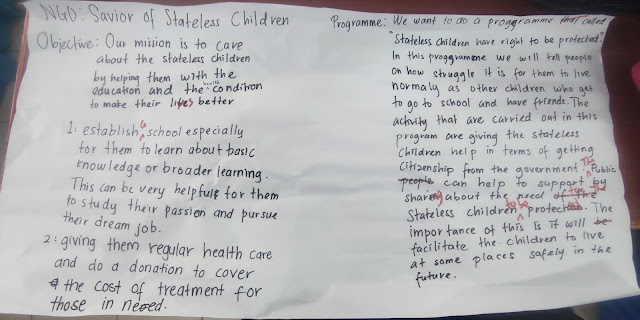*Based on Manual Kesedaran Sivik Sekolah Menengah - Tajuk: Setia
*This lesson is a modification and extension of the reading lesson in Chapter 2:2a Form 4 'Full blast' textbook but integrated with the Malaysian context.
Objectives:
1. Identify the objectives of Malaysian NGOs.
2. Create a mock NGO with 2 objectives based on an issue assigned to each group, and present it to their peers in English.
3. Plan a program for their NGO.
Materials: video, articles of Malaysian NGOs, worksheet, handouts of issues, big white paper
Activity:
Pre-lesson:
1. Students watch a video about NGOs.
2. Ask the students about what kinds of NGOs are there based on the video. Write their responses on the board.
Lesson 1:
1. Students read the texts of Malaysian NGOs and write down the aim of each objective in the worksheet.
2. Check students' answers.
Lesson 2:
1. Form students into groups of five.
2. Distribute the handout of issues to every group. Assign one group to one type of issue.
3. Distribute a big white paper (alternative: get them to present in PowerPoint form) and have them write their objectives and program for their NGOs (remind them to refer to how the real NGOs write their objectives)
Sentences starters (can provide for low to intermediate-level students):
- Our mission is to...
- We are committed to...
- Our objective is to promote...
- We aim to raise awareness about...
- Our NGO's objective is to provide support for...
- We strive to achieve positive change in...
- We aim to provide resources and assistance to...
4. Students present their mock NGO and their program to the class
Post-lesson:
1. Ask students question (the response can either be verbal or written):
a) After doing the activity, how do you think NGOs are important for the country?
Reflection: Some students may lack ideas to plan a program for their mock NGO so provide elements such as the name of the program, the recipients or participants, and the activities as a guide for the students.
Evidence for Lesson 2:











Comments
Post a Comment